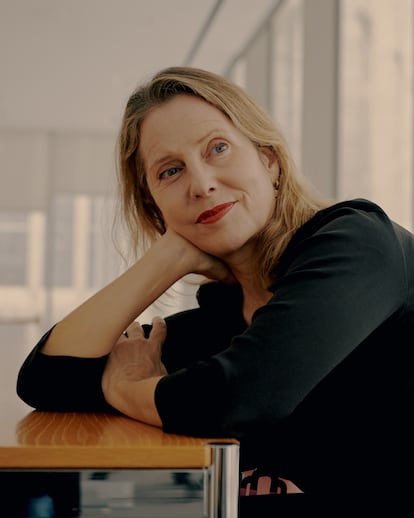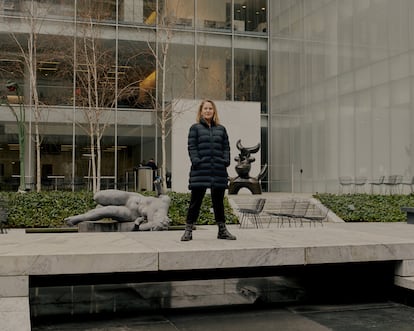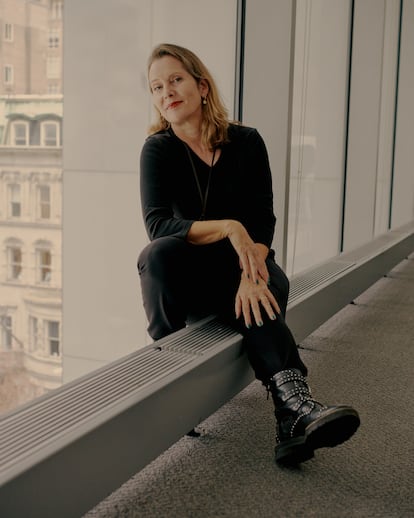Paola Antonelli: ‘I’m really proud that we have the @ symbol’
The Italian architect, senior curator of the department of Architecture & Design at The Museum of Modern Art (MoMA) in New York, has made history in graphic and industrial design with exhibitions covering the digital world, the universe of viruses and the faces of violence

Paola Antonelli, Senior Curator of the Department of Architecture & Design at The Museum of Modern Art (MoMA) in New York was, coincidentally, born in Sassari, Sardinia. It was 1963 and her father, an otolaryngologist, was working there as he had done previously in Milan, where Antonelli’s brother was born, and as he would later do in Ferrara, where her sister came into the world. What was not coincidental was her interview at MoMa, in 1994. Antonelli had earned a degree in Architecture from the Politecnico di Milano in 1990 and had also curated, designed, written and edited. She wrote an application latter asking for a position in New York and was granted an interview. Since then, she has called the Big Apple home and has never stopped thinking about what design is, and what it could be.
Her efforts to redefine the boundaries between disciplines has made her one of the most daring curators in the world, and yet she is enveloped in a serenity that belies her risk-taking approach. The interview begins in Valencia, where she inaugurated the World Design Capital Valencia 2022, and continues in New York. She receives EL PAÍS at her hotel. It is early but she has already been out, visiting Valencia’s Plaza Redonda and the central market. She is interested in making sure the recorder is working. She is dressed in beige, although for the photo session in New York she switches to black. She smiles and recalls that she was once a journalist.
Question. A designer, architect and curator not wearing black. Is that a statement of intent?
Answer. No. I just like colors. I dress in black when I don’t want to think. It’s a nice and safe uniform. But I enjoy the challenge of thinking a little more.
Q. Does that have something to do with being Italian?
A. That could be the case. In Italy, black is no associated with intellectualism. It could be because, for centuries, it was a color associated with mourning and despair.
Q. For decades you’ve been adamant that design is more than just chairs and now you’re in Valencia as a member of the panel to award a prize for the best chair.
A. Design is more than chairs, but chairs are also a part of it. It is the point of contact with the human body. A chair can be a manifesto. They are familiar objects. They form part of the home. That’s why they are the beginning. The problem is that everybody thinks design is just about chairs. That’s why I have had to push.
Q. You’ve said that ambiguity is the space for new design.
A. The 20th century was the century of specialization. That created hierarchies. There have always been hierarchies between art and applied art. When I started out in industrial design it was considered the final link in the creative professions. I studied architecture in Milan. [Achille] Castiglioni was my professor and his message was that design formed part of architecture. I advocate that architecture forms part of design. Design is a conceptual and pragmatic methodology that can be applied at many levels. It is a bridge. And in the 21st century the most important thing anything can be is something capable of uniting. It’s what we need.
Q. Do we design our own bodies?
A. Of course. I have tried to design myself several times, anxiously or erroneously, with diets, illnesses or exercise. We design our bodies by dressing them. I have never had any surgery, but I don’t rule out the possibility and I have nothing against it. I don’t have any tattoos but I love seeing them on other people. I also like scars. A non-binary or transsexual person completely redesigns their body and, in doing so, redesigns their life.
Q. Can viruses be designed?
A. As of a long time ago. There is one, very benign, in the MoMa collection.
Q. If everything is design, could the same thing happen to this discipline as happened to art, when anti-art also became art?
A. It is already impossible to define what design is. As such, when I try to do so, I expand it and limit it at the same time. I hope that, in the same way that people no longer ask what is music and what isn’t music, people will decide for themselves what is design and what isn’t design.
Q. If design is about asking the question, what will provide the answers?
A. Design responds and resolves, but its achievement is in making the questions be asked. There have been moments in history when the discipline has been expanded with architects and designers that have blown our minds.
Q. These moments have come, above all, during the coronavirus crisis, when creative professionals didn’t have much to do.
A. Of course. Economic crises and a lack of jobs tend to coincide with the moment in which we stop to think. We are going through one now, not just because of the pandemic, but because of the crisis of democracy and the environmental situation. This has led to a lot of designers becoming pragmatic again.
Q. But what MoMa supports is speculative.
A. Remember that great changes can begin as dreams.

Q. Is everything design?
A. I think perfume is design. And food. But not everything: telephone networks, for example, are not design.
Q. Why do we need museums to display design if it is everywhere already?
A. A museum is where people go to experience things. They used to be spaces where people approached art. But now they are meeting places, places of discovery and conversation.
Q. Design doesn’t always make the world a better place.
A. Amen. Although it took me a while to understand that. Perhaps because I am the daughter of doctors, I thought that designers took a kind of Hippocratic oath and worked for the good of humanity. In 2012, plans for 3D printed firearms were distributed and I had an epiphany: in the hands of humans, any tool can be used for evil.
Q. You set up MoMa’s earliest website.
A. When I want something and nobody can do it, I learn how to do it myself. I organized a few days of brainstorming and put forward: renaissance or revolution? Revolution won. People don’t want to be given rights. They want to conquer them. Revolution doesn’t have to be groundbreaking. It can be systematic. We are witnessing that with Black Lives Matter and MeToo. They change the way people think and repair faults in the coexistence of the system. They are forms of revolution.
Q. Is it not contradictory to start a revolution from an institution that represents power?
A. You can do it from within the system. Ten years ago, we started study groups to look at things we didn’t know. We documented other forms of modernity to avoid eurocentrism and the predominant point of view being that of the white, Western male. The MoMa collection has been transformed in response to this wider and more inclusive knowledge. That makes me proud. In 2019 we not only extended the building, we reorganized the criteria of the collection. That is a systematic revolution. The awareness that change is needed comes from within and then outer forces are sought out to make it happen. That is what design does.
Q. The @ symbol is a design in the MoMa collection. How do you go about buying something like that?
A. It can’t be bought. The beautiful thing about design is that there are so many ways to have it. You can buy objects and put them in display cabinets or you can own something that everybody uses. I’m really proud that we have the @ symbol. I read its history. It has existed since medieval times. Monks used it as the Latin preposition ad, which means “with relation to.” I found out that merchants in Venice and Geneva used it to connect price and quantity. It was on typewriters. In 1971, an engineer at MIT was commissioned by the US government to design the web. And he used the @ symbol to link the parts together (name and website). The @ symbol is a bridge in the public domain. That is better than owning it because it redefines the role of museums, not as places that remove works of art from circulation, but as places that tell stories and create knowledge.
Q. How do you decide what to add to the collection while allowing time for trends to cool off?
A. This is an habitual source of friction with my colleague who are in favor of that pause. You’re competing with the great museums, like the Centre Pompidou, and if you don’t take risks and you wait too long, you miss out. They are going to buy everything and you’re going to be left behind. It is necessary to take risks.
Q. At what price?
A. I’m not going to mention names, but I have a few pieces of very large furniture that shouldn’t be in the MoMa collection. Of course you make mistakes, but I prefer to make mistakes and acquire something questionable than miss out on the opportunity to have something that should be in the collection.
Q. Has anything been removed from the collections?
A. We can do it, but only to sell the pieces if we find something better from the same period. A few pieces of plastic furniture from the 1970s have deteriorated, for example.
Q. Has that made you reconsider plastics?
A. No.

Q: It was meant to be the future and now it is the devil.
A: It has been all of those things, but it will have its day again with bioplastics.
Q: Plastic was in museums before women were.
A: No! Aino Alto and Ray Eames were, finally, recognized years ago. But we can still improve. What gives me greatest hope is gender fluidity. I think true equality will come when genders cease to exist.
Q: Has a company ever paid to have video games in the MoMa collection?
A: No.
Q: But the fashion industry has paid to feature in museums.
A: At MoMa we have sponsors and trustees. They discuss acquisitions between them and put them forward. Companies can donate objects.
Q: Video games generate double the money that the movie industry does.
A: Yes.
Q: But they also cause addiction in children.
A: It is our point of view as adults that paints them as addicts.
Q: Psychiatrists have made complaints.
A: Is it comparable with other addictions? In that case then of course it is a problem. And maybe I should rethink the idea. But I think it is important to document the world in which we live. Video games are addictive, but they are also constructive. They are feats of design. It is a fascinating subject. There is as much violence as in collections of painting and sculpture. Why should design avoid the issue?
Q: Could an atomic bomb be included in a design collection?
A: No.
Q: Drugs? LSD?
A: I put on an exhibition called Safe. Disco Drugs. And the director asked if the promotional poster could imply that the museum supported the use of drugs. It was completely the opposite: it supported access to information so that young people knew what they were getting into.
Q: Do you think design is the greatest form of artistic expression?
A: The artist can be involved or not. The designer is responsible for the effect their work has on everybody else.

Q. What led to you to want to define design?
A. In 2001 I started to study how people worked. I was interested above all in change. The radical world of the 1960s and 1970s described design as a tool capable of changing behavior. When the world requires a great change, objects symbolize it and promote it. Design reacts to the world. And that binds it to it swiftly and profoundly.
Q. The ideas of radical architects in the 1960s didn’t get much further than that: ideas
A. Some were translated into buildings. Think of the Centre Pompidou. That is my favorite building.
Q. It has needed a lot of renovations.
A. Of course. Even concrete needs continuous repairs. That’s part of life.
Q. Where is nature incorporated into the Pompidou?
A. In the contrast. I like it because it is a rocket that has landed on earth. It doesn’t move. But it moves you. We curators try to show what is not seen. It is not just the shock of the new. Sometimes it is the surprise of the old.
Q. Do you miss Italy?
A. No. I go there a lot. I’m a New Yorker. I love it here. But then when I’m outside New York I think to myself: why do I live there, it’s no neurotic…
Q. What was your childhood like?
A. People say I was a happy and clever kid. I drew, I sang, I acted and I pretended I could read. I was also overweight and insecure and a bit of a loner. I have a photograph of a party where all the other kids are playing and I’m laying on a bed, reading a book.
Q. What sacrifices have you made?
A. It’s difficult to know. I don’t trust my own honesty when it comes to taking stock. What most differentiates my life from another, shall we say, more conventional one is that, although I have been with the same partner for 26 years, we have never had children. Was it my career? Did we decide not to? Is it because we live in New York? Because my family were very far away? Did I not want children? Am in not in the world to be a mother? Every answer would be incomplete and indulgent. But we don’t have any regrets, at least not at the moment. I have worked a lot. I’m sure I have missed out on things, but I have recouped the effort I have put in.
Q. What do you hope the future will bring?
A. We can only hope. Hope that the invasion of Ukraine stops, that they can remain free and rebuild their country with the help of the rest of the world. I would like other conflicts and other injustices to be more visible. I would like the pandemic to end, I would like democracy to no longer be under threat and that we as citizens to be able to strengthen it. I would like for there to be an agreement to protect the planet… I sound like a Miss World contestant, but I would like world peace.
Q. Is the virtual world the future?
A. It has always existed. Technology does not define it; it’s a state of mind. For centuries, religion transported us to this world. In the future, it will not only be an escape, it will be the world.
Tu suscripción se está usando en otro dispositivo
¿Quieres añadir otro usuario a tu suscripción?
Si continúas leyendo en este dispositivo, no se podrá leer en el otro.
FlechaTu suscripción se está usando en otro dispositivo y solo puedes acceder a EL PAÍS desde un dispositivo a la vez.
Si quieres compartir tu cuenta, cambia tu suscripción a la modalidad Premium, así podrás añadir otro usuario. Cada uno accederá con su propia cuenta de email, lo que os permitirá personalizar vuestra experiencia en EL PAÍS.
¿Tienes una suscripción de empresa? Accede aquí para contratar más cuentas.
En el caso de no saber quién está usando tu cuenta, te recomendamos cambiar tu contraseña aquí.
Si decides continuar compartiendo tu cuenta, este mensaje se mostrará en tu dispositivo y en el de la otra persona que está usando tu cuenta de forma indefinida, afectando a tu experiencia de lectura. Puedes consultar aquí los términos y condiciones de la suscripción digital.
More information
Últimas noticias
Most viewed
- Reinhard Genzel, Nobel laureate in physics: ‘One-minute videos will never give you the truth’
- Oona Chaplin: ‘I told James Cameron that I was living in a treehouse and starting a permaculture project with a friend’
- Pablo Escobar’s hippos: A serious environmental problem, 40 years on
- Charles Dubouloz, mountaineering star, retires at 36 with a farewell tour inspired by Walter Bonatti
- Why we lost the habit of sleeping in two segments and how that changed our sense of time











































